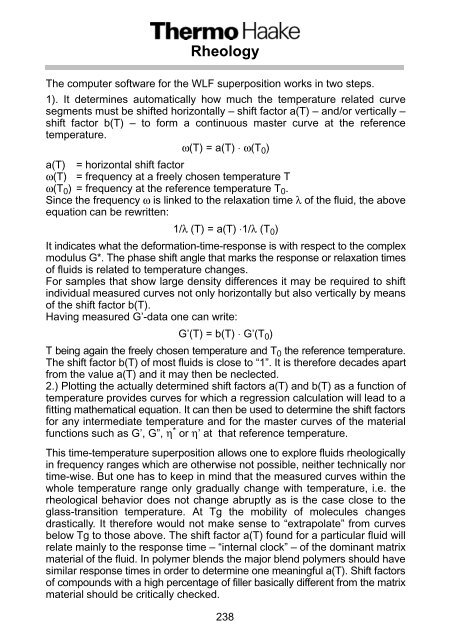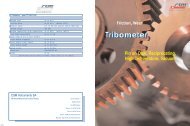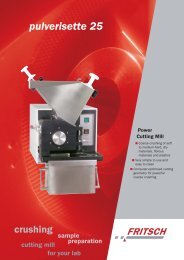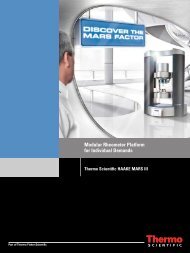A Practical Approach to Rheology and Rheometry
A Practical Approach to Rheology and Rheometry
A Practical Approach to Rheology and Rheometry
You also want an ePaper? Increase the reach of your titles
YUMPU automatically turns print PDFs into web optimized ePapers that Google loves.
<strong>Rheology</strong><br />
The computer software for the WLF superposition works in two steps.<br />
1). It determines au<strong>to</strong>matically how much the temperature related curve<br />
segments must be shifted horizontally – shift fac<strong>to</strong>r a(T) – <strong>and</strong>/or vertically –<br />
shift fac<strong>to</strong>r b(T) – <strong>to</strong> form a continuous master curve at the reference<br />
temperature.<br />
ω(T) = a(T) ⋅ ω(T0) a(T) = horizontal shift fac<strong>to</strong>r<br />
ω(T) = frequency at a freely chosen temperature T<br />
ω(T0) = frequency at the reference temperature T0. Since the frequency ω is linked <strong>to</strong> the relaxation time λ of the fluid, the above<br />
equation can be rewritten:<br />
1/λ (T) = a(T) ⋅1/λ (T0) It indicates what the deformation-time-response is with respect <strong>to</strong> the complex<br />
modulus G*. The phase shift angle that marks the response or relaxation times<br />
of fluids is related <strong>to</strong> temperature changes.<br />
For samples that show large density differences it may be required <strong>to</strong> shift<br />
individual measured curves not only horizontally but also vertically by means<br />
of the shift fac<strong>to</strong>r b(T).<br />
Having measured G’-data one can write:<br />
G’(T) = b(T) ⋅ G’(T0) T being again the freely chosen temperature <strong>and</strong> T0 the reference temperature.<br />
The shift fac<strong>to</strong>r b(T) of most fluids is close <strong>to</strong> “1”. It is therefore decades apart<br />
from the value a(T) <strong>and</strong> it may then be neclected.<br />
2.) Plotting the actually determined shift fac<strong>to</strong>rs a(T) <strong>and</strong> b(T) as a function of<br />
temperature provides curves for which a regression calculation will lead <strong>to</strong> a<br />
fitting mathematical equation. It can then be used <strong>to</strong> determine the shift fac<strong>to</strong>rs<br />
for any intermediate temperature <strong>and</strong> for the master curves of the material<br />
functions such as G’, G”, η * or η’ at that reference temperature.<br />
This time-temperature superposition allows one <strong>to</strong> explore fluids rheologically<br />
in frequency ranges which are otherwise not possible, neither technically nor<br />
time-wise. But one has <strong>to</strong> keep in mind that the measured curves within the<br />
whole temperature range only gradually change with temperature, i.e. the<br />
rheological behavior does not change abruptly as is the case close <strong>to</strong> the<br />
glass-transition temperature. At Tg the mobility of molecules changes<br />
drastically. It therefore would not make sense <strong>to</strong> “extrapolate” from curves<br />
below Tg <strong>to</strong> those above. The shift fac<strong>to</strong>r a(T) found for a particular fluid will<br />
relate mainly <strong>to</strong> the response time – “internal clock” – of the dominant matrix<br />
material of the fluid. In polymer blends the major blend polymers should have<br />
similar response times in order <strong>to</strong> determine one meaningful a(T). Shift fac<strong>to</strong>rs<br />
of compounds with a high percentage of filler basically different from the matrix<br />
material should be critically checked.<br />
238






